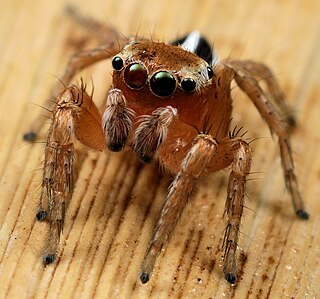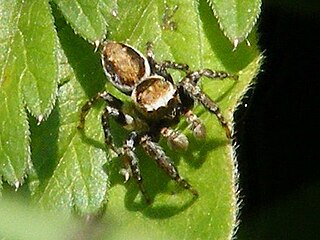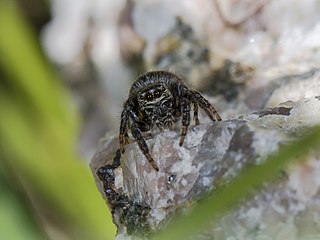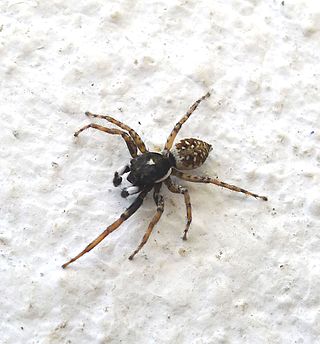
Pseudomogrus mirandus is a species of jumping spider in the genus Pseudomogrus. It has been found in Turkmenistan on the steppe, although it may also live in Afghanistan and Iran. The species was first defined by Wanda Wesołowska in 1991, one of over 500 described by the arachnologist. She originally placed it in the genus Yllenus, but was moved to the new genus Logunyllus in 2016, and then to its present designation in 2019. The spider is small, with a carapace measuring between 1.6 and 1.78 mm long and an abdomen between 1.4 and 2.3 mm long. The male has a red-brown or dark brown carapace and dark grey abdomen, the female a brown carapace and greyish-brown abdomen. All have a covering of small white scales. The spider has yellow legs. The copulatory organs are distinctive and enable the spider to be distinguished from others in the genus. The female epigyne has a half-moon-shaped pocket and simple insemination ducts that lead to spherical spermathecae. The male lacks the ventral tibial apophysis common in other species and has a compound terminal apophysis that is of a similar length to its thin embolus.

Menemerus davidi is a species of jumping spider in the genus Menemerus that lives in North Africa and the Middle East. The species was first identified in 1999 by Jerzy Prószyński and Wanda Wesołowska working initially independently, and then together. The first description was published by Wesołowska, one of over 500 descriptions she produced during her lifetime. The spider is small, with a carapace that ranges between 2.3 and 3.0 millimetres long and an abdomen that is 2.2 and 3.2 millimetres long, although the female is larger than the male. The carapace is generally a uniform dark brown while the abdomen has a pattern of a light brown stripe and white patches that serves to distinguish it from the related Menemerus animatus. Otherwise, it is its copulatory organs that most distinguish the species from others in the genus. It has distinctive internal structure to the female epigyne. The wide copulatory openings lead down the centre of the spider to the spermathecae while there is also a short narrower channel that runs to the rear of the spider with a prominent scent pore at the end. The male has a noticeably smaller embolus and a distinctive dorsal tibial apophysis.

Menemerus desertus is a species of jumping spider in the genus Menemerus that lives in Algeria. The species was first described in 1999 by Wanda Wesołowska, one of over 500 descriptions she produced during her lifetime. The spider is small, with a carapace that ranges between 2.5 and 2.7 millimetres long and an abdomen that is 2.7 and 4.7 millimetres long, although the female is larger than the male. The carapace is generally a uniform dark brown while the abdomen has a yellow stripe. Otherwise, it is its copulatory organs that most distinguish the species from others in the genus. The female epigyne has ridges at the entrance to the insemination ducts. The male has a distinctive dorsal tibial apophysis.

Evarcha flagellaris is a species of jumping spider in the genus Evarcha that lives in Kenya and South Africa. The species was first described in 2011 by Charles Haddad and Wanda Wesołowska. The spider is small, with a carapace measuring between 2.0 and 2.4 mm long and an abdomen between 1.9 and 3.6 mm long. The female is larger than the male, particularly in the size of its abdomen. Both have stripes on the abdomen, the male being more distinct with four brown stripes contrasting with a yellow background. This is similar to the related Evarcha striolata, from which it can be distinguished by the presence of an orange scutum. It can also be identified by its copulatory organs. The female has very wide looping insemination ducts that lead to heavily sclerotized multi-chambered spermathecae. The male has a long straight projection from its tibia or tibial apophysis and a whip-like embolus. It is after the latter feature that it is named.

Evarcha acuta is a species of jumping spider in the genus Evarcha that lives in Namibia, Seychelles and South Africa. The species was first described in 2006 by Wanda Wesołowska. The spider is small, with a carapace measuring typically 1.6 mm (0.06 in) long and an abdomen between 1.4 and 1.9 mm long. The carapace is light brown with a short black eye field. The abdomen has patterns that vary depending on geography. The holotype, found near Brandberg Mountain in Namibia, has lines of brown patches on the top. Examples found in Free State, South Africa, have black lines on the top and sides. The spider can be most easily distinguished from other spiders in the genus by its copulatory organs. The male has a distinctive notch on a long straight projection from its tibia known as a tibial apophysis and a long embolus. The female has not been described.

Evarcha awashi is a species of jumping spider in the genus Evarcha that lives in Ethiopia. The species was first described in 2008 by Wanda Wesołowska and Beata Tomasiewicz. The spider is small, with a cephalothorax measuring between 2.0 and 2.3 mm long and an abdomen between 1.9 and 2.4 mm long. The male and female are similar in size but differ slightly externally. The male carapace is orange while the female is brown, both with a darker eye field. The pattern on the abdomen is generally similar, a combination of light background and dark patches, but the female has less contrast between the two. The legs are mainly brown with yellowish tarsi. Its copulatory organs are distinctive. The male has a short embolus that follows the palpal bulb and a sharp tooth on its short wide and blunt protrusion on its palpal tibia, or tibial apophysis. The female has insemination ducts that narrow into multi-chambered spermathecae.

Evarcha pinguis is a species of jumping spider in the genus Evarcha that lives in Ethiopia. The species was first described in 2008 by Wanda Wesołowska and Beata Tomasiewicz. The spider is larger than others in the genus, with a cephalothorax measuring 3.4 mm (0.13 in) long and an abdomen between 4.7 mm (0.19 in) long. The spider is dark brown and hairy apart from a lighter streak on the back of the carapace and a pattern of light chevrons down the back of the abdomen. The legs are brown, the front four being thicker and shorter than the rest. The copulatory organs are distinctive. The female has marked sclerotization to the edge of its epigyne. The male has not been described.

Evarcha rotundibulbis is a species of jumping spider in the genus Evarcha that lives in Ethiopia. The species was first described in 2008 by Wanda Wesołowska and Beata Tomasiewicz. The spider is small to medium-sized, with a cephalothorax measuring between 2.4 and 2.7 mm long and an abdomen between 2.3 and 2.6 mm long. The carapace is light brown with a dark brown eye field. The abdomen is russet with a yellowish pattern of arrows and spots. The spider has brown and yellow legs. Its copulatory organs are unusual and help identify it. The male has a distinctive rounded palpal bulb that is recalled in the name of the species. It also has a very short forked embolus and a shovel-like projection, or apophysis, on the palpal tibia that distinguishes it from other related species. The female has not been described.

Evarcha russellsmithi is a species of jumping spider in the genus Evarcha that lives in Ethiopia. The species was first described in 2008 by Wanda Wesołowska and Beata Tomasiewicz. The spider is small to medium-sized, with a cephalothorax measuring typically 2.2 mm (0.09 in) long and an abdomen 1.8 mm (0.07 in) long. The carapace is yellowish with dark rings around the spider's eyes. The abdomen is brown with an indistinct pattern of spots and lines. The legs are generally brown. The copulatory organs are distinctive. The male has a projection, or apophysis, from the palpal tibia that is has a series of tooth-like features, and a very short embolus that is attached to another very small apophysis. The female has multi-chambered spermathecae and distinctive accessory glands.

Pellenes striolatus is a species of jumping spider in the genus Pellenes that lives on Socotra Island, Yemen. It was first described in 2002 by Wanda Wesołowska and Antonius van Harten. The spider is smaller than many in the genus, with a carapace that measures typically 1.4 mm (0.06 in) in length and an abdomen that is between 1.3 and 2 mm long. The female has a larger abdomen than the male. Both are generally very dark, nearly black, and have a distinctive white pattern on the abdomen. The pattern consists of a central white stripe that is flanked by white diagonal lines, and is recalled in the species name, which can be translated "thinly streaked". The spider has copulatory organs that are similar to other species in the genus. The female has a shallow pocket in the middle of its epigyne and the male has a thick embolus.

Evarcha bakorensis is a species of jumping spider in the genus Evarcha that lives in Guinea, Ivory Coast and Nigeria. It thrives in savanna grasslands. The species was first described in 2002 by Christine Rollard and Wanda Wesołowska. The spider is small, with a cephalothorax measuring between 1.6 and 1.8 mm long and an abdomen that is between 1.3 and 1.9 mm long. The female is larger than the male. The cephalothorax has a light brown topside, or carapace, yellow underside, or sternum, and darker sides. The abdomen is greyish-brown or brown and has a lighter pattern on it. The spider has generally brown legs. It has distinctive copulatory organs. The female has a large membrane in the centre of its epigyne while the male has a straight and blunt tibial apophysis, or projection on its palpal tibia.

Evarcha certa is a species of jumping spider in the genus Evarcha that lives in Guinea and Ethiopia. It thrives in grasslands, particularly near bodies of water like the Baro River and in areas of high altitude such as the Guinea Highlands. The species was first described in 2002 by Christine Rollard and Wanda Wesołowska. The spider is small, with a cephalothorax measuring between 2.6 and 2.9 mm long and an abdomen that is between 2.7 and 3.4 mm long. The cephalothorax has a reddish-brown topside, or carapace, with a darker eye field, and an orange underside, or sternum. The abdomen has a pattern consisting of irregular brown patches, although this differs between individual spiders. The spider has orange or yellow legs. It has distinctive copulatory organs. The female has relatively simple spermathecae that are heavily sclerotized and short insemination ducts. The male has not been described.

Evarcha maculata is a species of jumping spider in the genus Evarcha that lives in Guinea, Ivory Coast and Ethiopia. It thrives in savanna, particularly in the Guinea Highlands and near bodies of water like the Awash River. The species was first described in 2002 by Christine Rollard and Wanda Wesołowska. The spider is small, with a cephalothorax measuring between 1.7 and 2.3 mm long and an abdomen that is between 1.6 and 3.6 mm long. The female is generally larger than the male, although there are exceptions, particularly amongst those found in Guinea. The cephalothorax has a yellowish topside, or carapace, with a darker eye field, and an yellow or yellowish-orange, or sternum. The abdomen has a distinctive pattern that is basically shaped like a capital "H", referred to in the species name, which can be translated "spotted". The spider has orange or yellow legs. It has distinctive copulatory organs. The female has distinctively shaped insemination ducts. The male has a very short curved embolus.

Evarcha grandis is a species of jumping spider in the genus Evarcha that lives in Nigeria. The species was first described in 2011 by Wanda Wesołowska and Anthony Russell-Smith. It is larger than typically for the genus, which is reflected in the species name derived from the Latin word that means "large". The spider has a cephalothorax that is typically 3.6 mm (0.14 in) long and an abdomen 5.7 mm (0.22 in) long. It has a brown carapace with a black eye field and greyish-brown abdomen. It has long brown bristles on its clypeus, or face, and white lines on its cheeks. The spider's legs are dark brown. Apart from its size, the spider's copulatory organs are the most clear way to identify it. The female has pockets towards the midpoint, rather than the rear, of its epigyne, short insemination ducts and large spermathecae. The male has not been described.

Evarcha idanrensis is a species of jumping spider in the genus Evarcha that lives in Nigeria. It is named after Idanre Hill in Ondo State, where it was first found. The species was first described in 2011 by Wanda Wesołowska and Anthony Russell-Smith. The spider is hard to distinguish from other spiders in the genus. It has a cephalothorax measuring between 2.1 and 2.5 mm long and an abdomen between 2.2 and 3.5 mm long. It has a yellow carapace with a black eye field and light brown legs. The abdomen is brownish-grey with an indistinct pattern on its back. Apart from the size of the epigyne, the female's copulatory organs are similar to other members of the genus. The male has not been described.

Pseudomogrus improcerus is a species of jumping spider in the genus Pseudomogrus that is endemic to Yemen. The species was first defined by Wanda Wesołowska and Antonius van Harten in 1994. They originally placed it in the genus Yllenus, but was moved to the new genus Logunyllus in 2016, and then to its present designation in 2019. The spider is small, with a carapace measuring between 1.84 and 1.9 mm long and an abdomen between 2.05 and 2.1 mm long. The female has a red-brown or brown carapace and brownish-grey abdomen covered in small brown, grey, white and golden scales. Some examples have a band across the top of the abdomen. The spider has yellow legs. The copulatory organs are distinctive and enable the spider to be distinguished from others in the genus. The female epigyne has simple insemination ducts and large accessory glands.

Pseudomogrus logunovi is a species of jumping spider in the genus Pseudomogrus that lives in United Arab Emirates. The species was first defined by Wanda Wesołowska and Antonius van Harten in 2010. They originally placed it in the genus Yllenus, but it was moved to the new genus Logunyllus in 2016, and then to its present designation in 2019. The spider is small, with a cephalothorax that is between 1.5 and 2.0 mm long and an abdomen between 1.6 and 2.2 mm long. The female is larger than the male. The female has a plain brown carapace while the male has two white stripes on its darker surface. Both have brown patches on their yellow legs. The spider can be identified by its copulatory organs. The male has a straight spike on the tibia of its pedipalps, or tibial apophysis, a long embolus with a narrow accompanying terminal apophysis and a small tegulum. The female has shorter insemination ducts than species like Pseudomogrus salsicola.

Evarcha arabica is a species of jumping spider in the genus Evarcha that lives in Yemen. The species was first described in 2007 by Wanda Wesołowska and Antonius van Harten. The spider is small, with a carapace that measures between 2.1 and 2.7 mm long and an abdomen that is between 1.8 and 3.2 mm long. The female is generally larger and lighter than the male. The spider's eye field is darker. The top of the male abdomen is blackish-brown with a pattern of white dots and a large yellowish-orange belt. The top of the female abdomen has similar white dots but is mainly yellow with small darker dots. The male's legs are brown and yellow while the female's are orange to yellow. It has distinctive copulatory organs. The female has accessory glands near the copulatory openings and simple bean-like spermathecae. The male has a thin embolus and a tibial apophysis that has a forked tip.

Menemerus pallescens is a species of jumping spider in the genus Menemerus that lives in Yemen. The spider was first described in 2007 by Wanda Wesołowska and Antonius van Harten. Other examples have been found in the Emirate of Dubai. The spider is medium sized with a carapace that is between 2.5 and 3.1 mm long and abdomen between 3.4 and 4.2 mm long. The carapace is dark brown with white stripes at the back. The abdomen is yellowish-beige or light grey, sometimes with a pattern of lines and spots. The legs are yellow. The spider is hard to distinguish from others in the genus without a study of its copulatory organs. The spider has a shallow notch at rearmost edge of its epigyne and long accessory glands. The male has not been described.

The Fayda Jumper or Afraflacilla fayda is a species of jumping spider in the genus Afraflacilla that lives in the United Arab Emirates. The spider was first described in 2010 by Wanda Wesołowska and Antonius van Harten. The spider is small, with an cephalothorax that is typically 1.8 mm (0.07 in) and an abdomen typically 2.9 mm (0.11 in) long. The female has a distinctive design on its abdomen that includes a pattern of an indistinct light patch in the centre and two light patches to the rear on a greyish-beige background, darker to the end. In comparison, the carapace is a uniform brown with a darker brown eye field. The spider's legs are yellow, the first legs being larger and featuring stridulatory apparatus. It has distinctive copulatory organs. The female has long winding insemination ducts and large spermathecae. The male has not been described.




















